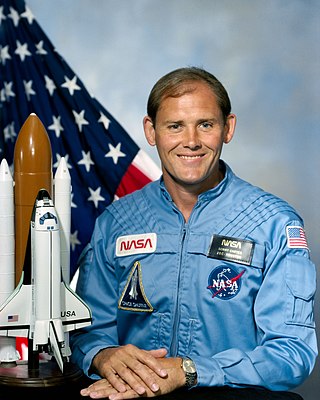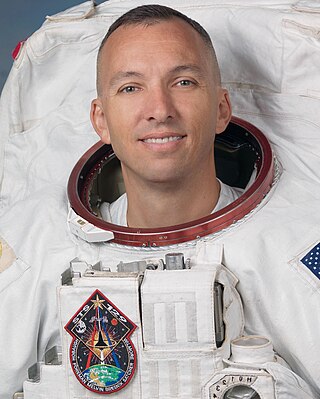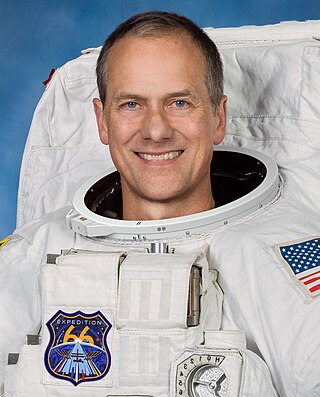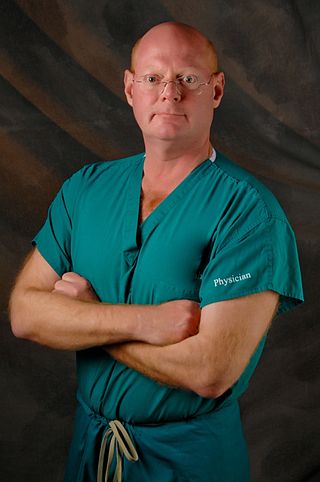
Manley Lanier "Sonny" Carter Jr., M.D., , was an American chemist, physician, professional soccer player, naval officer and aviator, test pilot, and NASA astronaut who flew on STS-33.

David McDowell Brown was a United States Navy captain and NASA astronaut. He died on his first spaceflight, when the Space Shuttle Columbia (STS-107) disintegrated during orbital reentry into the Earth's atmosphere. Brown became an astronaut in 1996 but had not served on a space mission prior to the Columbia disaster. He was posthumously awarded the Congressional Space Medal of Honor.

Laurel Blair Clark was a NASA astronaut, medical doctor, United States Navy captain, and Space Shuttle mission specialist. She died along with her six fellow crew members in the Space Shuttle Columbia disaster. Clark was posthumously awarded the Congressional Space Medal of Honor.

Frederick Hamilton "Rick" Hauck is a retired captain in the United States Navy, a former fighter pilot and NASA astronaut. He piloted Space Shuttle mission STS-7 and commanded STS-51-A and STS-26.

Dale Allan Gardner was a NASA astronaut, and naval flight officer who flew two Space Shuttle missions during the mid 1980s.

Dafydd Rhys "David" Williams is a Canadian physician, public speaker, author and retired CSA astronaut. Williams was a mission specialist on two Space Shuttle missions. His first spaceflight, STS-90 in 1998, was a 16-day mission aboard Space Shuttle Columbia dedicated to neuroscience research. His second flight, STS-118 in August 2007, was flown by Space Shuttle Endeavour to the International Space Station. During that mission he performed three spacewalks, becoming the third Canadian to perform a spacewalk and setting a Canadian record for total number of spacewalks. These spacewalks combined for a total duration of 17 hours and 47 minutes.

Norman Earl Thagard, is an American scientist and former U.S. Marine Corps officer and naval aviator and NASA astronaut. He is the first American to ride to space on board a Russian vehicle, and can be considered the first American cosmonaut. He did this on March 14, 1995, in the Soyuz TM-21 spacecraft for the Russian Mir-18 mission.

James Philip Bagian, is an American physician, engineer, and former NASA astronaut of Armenian descent. During his career as an astronaut, he logged 337 hours of space-flight, over two missions, STS-29 and STS-40. After leaving NASA in 1995, Bagian was elected as a member of the Institute of Medicine. He was also elected as member into the National Academy of Engineering in 2000 for the integration of engineering and medical knowledge in applications to aerospace systems, environmental technology, and patient safety.

Charles Eldon Brady Jr. was an American physician, a captain in the United States Navy and a NASA astronaut. He spent 16 days in space on the Space Shuttle's STS-78 flight in 1996.

Daniel Wheeler Bursch is a former NASA astronaut, and Captain of the United States Navy. He had four spaceflights, the first three of which were Space Shuttle missions lasting 10 to 11 days each. His fourth and final spaceflight was a long-duration stay aboard the International Space Station as a crew member of Expedition 4, which lasted from December 2001 to June 2002. This 196-day mission set a new record for the longest duration spaceflight for an American astronaut, a record simultaneously set with his crew mate Carl Walz. Their record has since been broken, and as of 2016 it is held by Scott Kelly, who flew a 340-day mission during Expeditions 43, 44 and 45.

Jerry Michael Linenger is a retired Captain in the United States Navy Medical Corps, and a former NASA astronaut who flew on the Space Shuttle and Space Station Mir.

John Michael "Mike" Lounge was an American engineer, a United States Navy officer, a Vietnam War veteran, and a NASA astronaut. A veteran of three Space Shuttle flights, Lounge logged over 482 hours in space. He was a mission specialist on STS-51-I (1985) and STS-26 (1988) and was the flight engineer on STS-35 (1990).

Richard Michael Linnehan is a United States Army veterinarian and a NASA astronaut.

Joseph Richard Tanner is an American instructor at the University of Colorado Boulder, mechanical engineer, a former naval officer and aviator, and a former NASA astronaut. He was born in Danville, Illinois. He is unusual among astronauts as he did not have a background in flight test nor did he earn any advanced academic degrees. Typically those who did not do military flight test have an M.D. or Ph.D., if not a master's, whereas Tanner's path to becoming an astronaut followed operational military flying and then into NASA for operational jet training before being selected into the NASA Astronaut Corps in 1992, following an unsuccessful application in 1987.

Heidemarie Martha Stefanyshyn-Piper is an American Naval officer and former NASA astronaut. She has achieved the rank of Captain in the United States Navy. She is also a qualified and experienced salvage officer. Her major salvage projects include de-stranding the tanker Exxon Houston off the coast of Barbers Point, on the island of Oahu, Hawaii, and developing the plan for the Peruvian Navy salvage of the Peruvian submarine Pacocha.

Randolph James "Komrade" Bresnik is a retired officer in the United States Marine Corps and an active NASA astronaut. A Marine Aviator by trade, Bresnik was selected as a member of NASA Astronaut Group 19 in May 2004. He first launched to space on STS-129, then served as flight engineer for Expedition 52, and as ISS commander for Expedition 53.

Thomas Henry Marshburn is an American physician and a former NASA astronaut. He is a veteran of three spaceflights to the International Space Station and holds the record for the oldest person to perform a spacewalk at 61 years old.

Michael Reed Barratt is an American physician and a NASA astronaut. Specializing in aerospace medicine, he served as a flight surgeon for NASA before his selection as an astronaut, and has played a role in developing NASA's space medicine programs for both the Shuttle-Mir Program and International Space Station. His first spaceflight was a long-duration mission to the International Space Station, as a flight engineer in the Expedition 19 and 20 crew. In March 2011, Barratt completed his second spaceflight as a crew member of STS-133. Barratt will pilot the SpaceX Crew-8 mission in spring 2024.

Josef F. Schmid is a German-American physician, NASA flight surgeon and a major general in the United States Air Force Reserves. He served as an aquanaut on the joint NASA-NOAA NEEMO 12 underwater exploration mission in May 2007. On 8 October 2021 he became one of the first humans to be Holoported off the planet and into space, visiting the International Space Station by telepresence.

Sean Kevin Roden was a NASA flight surgeon with multiple roles for medical operations including for the International Space Station (ISS) from 2004 to 2007.




















